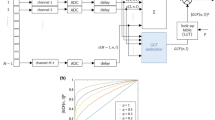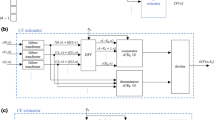Abstract
Purpose
Beamforming using the generalized coherence factor (GCF) reduces sidelobe artifacts and provides an excellent contrast-to-noise ratio. We previously proposed GCFreal, a method to calculate GCF without generating analytic signals, and GCFbin, a method to calculate GCF by binarizing the received signals. In this study, we applied these methods to in vivo data and showed the effect of the computational complexity reduction on contrast performance.
Methods
Channel RF data were acquired from the human liver and gallbladder. We set up several observation points in each data set and investigated the mechanism that causes the differences in contrast performance among the methods based on the signals and their power spectra in the channel direction.
Results
For GCF and GCFreal, the obtained values were almost the same. However, there were large differences in GCFbin from GCF when the signals from the focus point or from outside the focus point were received on different channels. This is because the amplitudes of the signals with high coherence and those with low coherence were changed by binarizing the signals.
Conclusion
While GCFbin can significantly reduce the computational complexity, there are differences in the values of GCFbin and GCF due to binarizing of the received signals. However, this difference resulted in GCFbin being superior to GCF in terms of artifact reduction. This is owing to the elimination of amplitude information in GCFbin, which makes it a new efficient coherence factor with different characteristics from GCF.








Similar content being viewed by others
References
Burckhardt CB. Speckle in ultrasound B-mode scans. IEEE Trans Son Ultrason. 1978;25:1–6.
Wagner RF, Smith SW, Sandrik JM, et al. Statistics of speckle in ultrasound B-scans. IEEE Trans Son Ultrason. 1983;30:156–63.
Patterson MS, Foster FS. The improvement and quantitative assessment of B-mode images produced by an annular array/cone hybrid. Ultrason Imag. 1983;5:195–213.
Capon J. High-resolution frequency-wavenumber spectrum analysis. Proc IEEE. 1969;57:1408–18.
Synnevag JF, Austeng A, Holm S. Adaptive beamforming applied to medical ultrasound imaging. IEEE Trans Ultrason Ferroelectr Freq Control. 2007;54:1606–13.
Synnevag JF, Austeng A, Holm S. Benefits of minimum-variance beamforming in medical ultrasound imaging. IEEE Trans Ultrason Ferroelectr Freq Control. 2009;56:1868–79.
Hollman KW, Rigby KW, O’Donnell M. Coherence factor of speckle from a multi-row probe. Proc IEEE Ultrason Symp. 1999;2:1257–60.
Li PC, Li ML. Adaptive imaging using the generalized coherence factor. IEEE Trans Ultrason Ferroelectr Freq Control. 2003;50:128–41.
Wang SL, Chang CH, Yang HC, et al. Performance evaluation of coherence-based adaptive imaging using clinical breast data. IEEE Trans Ultrason Ferroelectr Freq Control. 2007;54:1669–78.
Camacho J, Parrilla M, Fritsch C. Phase coherence imaging. IEEE Trans Ultrason Ferroelectr Freq Control. 2009;56:958–74.
Wang Y, Zheng C, Peng H, et al. An adaptive beamforming method for ultrasound imaging based on the mean to standard deviation factor. Ultrasonics. 2018;90:32–41.
Hasegawa H, Kanai H. Effect of sub-aperture beamforming on phase coherence factor imaging. IEEE Trans Ultrason Ferroelectr Freq Control. 2014;61:1779–90.
Sakhaei SM. Optimum beamforming for sidelobe reduction in ultrasound imaging. IEEE Trans Ultrason Ferroelectr Freq Control. 2012;59:799–805.
Nilsen CIC, Holm S. Wiener beamforming and the coherence factor in ultrasound imaging. IEEE Trans Ultrason Ferroelectr Freq Control. 2010;57:1329–46.
Kanai H, Sato M, Koiwa Y, et al. Transcutaneous measurement and spectrum analysis of heart wall vibrations. IEEE Trans Ultrason Ferroelectr Freq Control. 1996;43:791–810.
Mallart R, Fink M. Adaptive focusing in scattering media through sound-speed inhomogeneities: The van Cittert Zernike approach and focusing criterion. J Acoust Soc Am. 1994;96:3721–32.
Hverven SM, Rindal OMH, Rodriguez-Molares A, et al. The influence of speckle statistics on contrast metrics in ultrasound imaging. IEEE Ultrason Symp. 2017. https://doi.org/10.1109/ULTSYM.2017.8091949.
Hisatsu M, Mori S, Arakawa M, et al. Generalized coherence factor estimated from real signals in ultrasound beamforming. J Med Ultrasonics. 2020;47:179–92.
Hisatsu M, Mori S, Arakawa M, et al. Low-complexity generalized coherence factor estimated from binarized signals in ultrasound beamforming. J Med Ultrasonics. 2021;48:259–72.
Rindal OMH, Rodriguez-Molares A, Austeng A. The dark region artifact in adaptive ultrasound beamforming. IEEE Intl Ultrasound Symp. 2017. https://doi.org/10.1109/ULTSYM.2017.8092255.
Author information
Authors and Affiliations
Corresponding author
Ethics declarations
Conflict of interest
The authors declare that they have no conflicts of interest.
Ethical approval
This study was approved by the institutional ethical committee and was performed with the informed consent of the subject.
Additional information
Publisher's Note
Springer Nature remains neutral with regard to jurisdictional claims in published maps and institutional affiliations.
About this article
Cite this article
Hisatsu, M., Mori, S., Arakawa, M. et al. Application of low-complexity generalized coherence factor to in vivo data. J Med Ultrasonics 49, 555–567 (2022). https://doi.org/10.1007/s10396-022-01243-1
Received:
Accepted:
Published:
Issue Date:
DOI: https://doi.org/10.1007/s10396-022-01243-1




